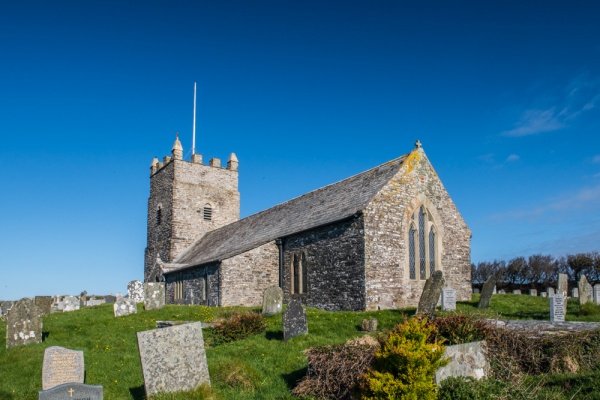
The village of Forrabury lies immediately south-west of Boscastle, and the medieval parish church of St Symphorian serves both communities. The dedication is unusual in England, though common in France. But why would a French saint be commemorated in an English church?
The answer probably lies with the Bottreaux family, the first Norman lords of the Forrabury area. The Bottreaux came to England with William the Conqueror and built a castle near the site of the present Methodist Chapel. The Bottreaux castle name was mangled by the English and became in time 'Boscastle'. It seems likely that the Bottreaux were familiar with St Symphorian and had the first recorded church here dedicated to this 3rd-century saint.
At that time the harbour area that is now Boscastle was yet to be settled, and the major settlements were around the Bottreaux castle and at Minster, further inland.
Very little remains of the Norman church, for in 1867 the entire church was rebuilt by architect JP St Aubyn to make room for more seating. Despite the rebuilding, many of the original medieval features remain, including the plainly carved Norman arch on the south side of the nave. The oldest feature inside the church is the simply carved 12th-century greenstone font, in the shape of a chalice, or cup. The bowl is carved with diagonal criss-cross patterns which change as you go around the circumference.

Medieval woodwork has been incorporated into the altar, pulpit, and credence table. The altar is particularly fine; the frontal is made from five medieval panels. The centre panel shows the Lamb and Flag symbols with the letter 'M' for Mary. Flanking this central panel are panels carved with symbols of the Passion. The altar in the Lady Chapel is made from a Jacobean table.
The pulpit is made from medieval bench ends, with panels depicting rabbits, swans, and an intriguing depiction of an ape on a stool. Look for the wall tablet to Sub Lieutenant James Kirkness of the Royal Navy, son of the Forrabury rector, who died in 1870 along with 499 other sailors when the HMS Captain sank off Cape Finisterre.
Another poignant tablet commemorates three members of the Brian family. John Brian died in infancy in 1824, his father George died the following year, aged just 30, and George's wife Mary died in 1827, also at the age of 30.
In the churchyard are some excellent 17th-century gravestones, including one to Johan Tub, who died in 1644. She was married to John Tub, and their son, also named John, died just three years later, in 1647. Against the church wall is a grave slab to Katherin Gaurd, dated 1675.
As you leave the churchyard look for the weathervane atop the south-east tower pinnacle; it is in the shape of a fish; a reminder of the close connection between the people of this area and the sea.

Forrabury Cross
Outside the south churchyard gate is a 10th-century wayside cross in a traditional Cornish wheelhead design, once used as a gatepost. You can still see holes in the cross where the gate was hinged. The cross stands 1.86m high, with very worn incised carvings of an equal-armed cross on both sides of the head.
The cross has stood here since at least 1866, but it is thought to have originally stood further along the church path near 'Cross Parke'. It is a very good example of a wheel headed cross, and was probably built as a waymarker.
Forrabury church was the subject of a poem by Rev. RS Hawker of Morwenstow entitled 'The Bells of Forrabury'. The poem relates an old legend that a ship bearing a set of bells for St Symphorian Church was sunk off Tintagel, and the ghostly sound of the bells ringing can still be heard over the waves.
Directly beside the church on Forrabury Common are a fascinating series of post-medieval 'stripfields' known as the Boscastle Stitches, one of the best surviving examples of this ancient system of farming based on walled terraces.
St Symphorian's church is usually open daylight hours to visitors and was open on both occasions that we visited. The location is fabulous, and it is well worth a short detour from Boscastle to seek out.
About Forrabury Church & Cross
Address: Forrabury Hill,
Boscastle,
Cornwall,
England, PL35 0DJ
Attraction Type: Historic Church
Location: Off the B3263 on the steep hill coming south out of Boscastle, or off the same road via Green Hill, on the outskirts of Forrabury.
Website: Forrabury Church & Cross
Location
map
OS: SX095908
Photo Credit: David Ross and Britain Express
NEARBY HISTORIC ATTRACTIONS
Heritage Rated from 1- 5 (low to exceptional) on historic interest
Boscastle Museum of Witchcraft and Magic - 0.3 miles (Museum) ![]()
Willapark and Forrabury Stitches - 0.4 miles (Countryside) ![]()
Boscastle, Minster Church - 1 miles (Historic Church) ![]()
Trevalga, St Petroc's Church - 1.1 miles (Historic Church) ![]()
Pentargon Waterfall - 1.1 miles (Countryside) ![]()
Trethevy, St Piran's Chapel and Holy Well - 1.6 miles (Historic Church) ![]()
St Nectan's Glen Waterfall & Hermitage - 1.7 miles (Prehistoric Site) ![]()
Rocky Valley Labyrinths - 1.7 miles (Prehistoric Site) ![]()
Nearest Holiday Cottages to Forrabury Church & Cross:
More self catering near Forrabury Church & Cross













